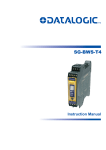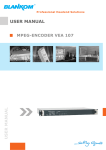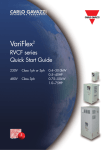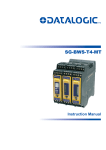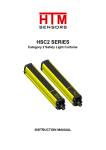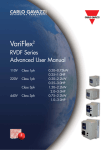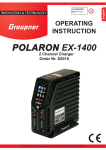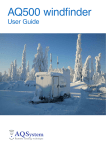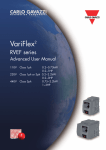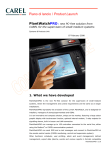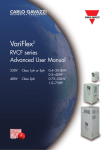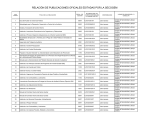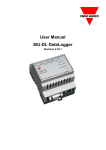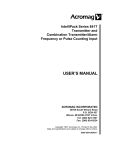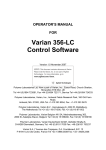Download Instruction manual SC2
Transcript
CARLO GAVAZZI Au t o m a t i o n C o m p o n e n t s Safety Light Curtain with infrared beams SC2 type Instruction manual Instruction Manual Safety Light Curtain SC2 ORIGINAL INSTRUCTIONS (ref. 2006/42/EC) CARLO GAVAZZI LOGISTICS S.p.A. Headquarter: Via Milano 13, I-20020 Lainate (MI) Tel.: +39 02 93176.1, Fax +39 02 9176.403 Internet: http://www.gavazziautomation.com SC2 Instruction Manual Ed. 03/2013 All brand and product names mentioned herein are for identification purposes only and may be trademarks or registered trademarks of their respective owners. Carlo Gavazzi shall not be liable for technical or editorial errors or omissions contained herein, not for incidental or consequential damages resulting from the use of this material. Specifications are subject to change without notice. Pictures are just an example. For special features and/or customization, please ask to our sales network. 20/01/2014 Instruction Manual Safety Light Curtain SC2 Specifications are subject to change without notice. Pictures are just an example. For special features and/or customization, please ask to our sales network. 20/01/2014 Instruction Manual Safety Light Curtain SC2 Index 1. GENERAL INFORMATION1 1.1. General description of the safety light curtains 4 1.1.1. Package contents 5 1.2. New features compared to the SB2 Series 6 1.3. How to choose the device 7 1.3.1. Resolution 7 1.3.2. Controlled height8 1.3.3. Minimum installation distance 9 1.4. Typical applications 12 1.5. Safety information 14 2. INSTALLATION MODE 2.1. Precautions to be observed for the choice and installation of the device 2.2. General information on device positioning 2.2.1. Minimum installation distance 2.2.2. Minimum distance from reflecting surfaces 2.2.3. Emitter and receiver orientation 2.2.4. Installation of several adjacent safety light curtains 2.2.5. Use of deviating mirrors 2.2.6. Controls after first installation 15 15 16 17 18 20 21 22 23 3. MECHANICAL MOUNTING 24 4. ELECTRICAL CONNECTIONS 4.1. Notes on connections 4.2. Earth connection 27 28 30 5. ALIGNMENT PROCEDURE 5.1. Correct alignment procedure 31 33 6. FUNCTIONING MODE 6.1. Reset mode 6.2. Test function 6.3. Reset function 34 34 34 34 7. DIAGNOSTIC FUNCTIONS 7.1. User interface 7.2. Diagnostic messages 35 35 36 8. PERIODICAL CHECKS 8.1. General information and useful data 8.2. Warranty 37 38 38 9. DEVICE MAINTENANCE 9.1. Product disposal 39 39 2 Specifications are subject to change without notice. Pictures are just an example. For special features and/or customization, please ask to our sales network. 20/01/2014 Instruction Manual Safety Light Curtain SC2 10. TECHNICAL DATA 40 11. LIST OF AVAILABLE MODELS 41 12. OVERALL DIMENSIONS 43 13. ACCESSORIES 13.1. Angled fixing bracket 13.2. Test pieces 13.3. Connection cables 44 44 46 46 14. GLOSSARY 47 Specifications are subject to change without notice. Pictures are just an example. For special features and/or customization, please ask to our sales network. 20/01/2014 3 Instruction Manual Safety Light Curtain SC2 1. General Information 1.1. General Description of the Safety Light Curtains The safety light curtains of the SC2 series are optoelectronic multibeam devices that are used to protect working areas that, in presence of machines, robots, and automatic systems in general, can become dangerous for operators that can get in touch, even accidentally, with moving parts. The light curtains of the SC2 series are Type 2 intrinsic safety systems used as accident-prevention protection devices and are manufactured in accordance with the international Standards in force for safety, in particular: CEI IEC 61496-1: 2004 Safety of machinery: electro-sensitive protective equipment. Part 1: General prescriptions and tests. CEI IEC 61496-2: 2006 Safety of machinery: electro-sensitive protective equipment. Particular requirements for equipment using active optoelectronic protective devices. The device, consisting of one emitter and one receiver housed inside strong aluminium profiles, generates infrared beams that detect any opaque object positioned within the light curtain detection field. The emitter and the receiver are equipped with the command and control functions. The connections are made through a M12 connector located in the lower side of the profile. The synchronisation between the emitter and the receiver takes place optically, i.e. no electrical connection between the two units is required. The microprocessor guarantees the check and the management of the beams that are sent and received through the units. The microprocessor – through some LEDs – informs the operator about the general conditions of the safety light curtain (see section 7 “Diagnostic functions”). The device consists in 2 units that, according to the model, are composed by one or several emitting and receiving modules. The receiver checks the control operations and safety actions. During installation, two yellow LEDs facilitate the alignment of both units (see section 5 “Alignment procedure”). As soon as an object, a limb or the operator’s body accidentally interrupts one or some of the infrared beams sent by the emitter, the receiver immediately opens the OSSD outputs and blocks the MPCE machine (if correctly connected to the OSSD). Some parts or sections of this manual containing important information for the operator are preceded by a note. Notes and detailed descriptions about particular characteristics of the safety devices in order to better explain their functioning. Special instructions regarding the installation process. 4 Specifications are subject to change without notice. Pictures are just an example. For special features and/or customization, please ask to our sales network. 20/01/2014 Instruction Manual Safety Light Curtain SC2 The information provided in the paragraphs following this symbol is very important for safety and may prevent accidents. Always read this information accurately and carefully follow the advice to the letter. This manual contains all the information necessary for the selection and operation of the safety devices. However, specialised knowledge not included in this technical description is required for the planning and implementation of a safety light curtain on a power-driven machine. As the required knowledge may not be completely included in this manual, we suggest the customer to contact Carlo Gavazzi Technical Service for any necessary information relative to the functioning of the SC2 light curtains and the safety rules that regulate the correct installation (see section 8 “Periodical checks”). Specifications are subject to change without notice. Pictures are just an example. For special features and/or customization, please ask to our sales network. 20/01/2014 5 Instruction Manual Safety Light Curtain SC2 1.1.1. Package Contents Package contains the following objects: • Receiver (RX) • Emitter (TX) • Quick Guide for first installation • CD with user manual and other documents • Checklist and periodical maintenance schedule • 4 angled fixing brackets and specific fasteners • 2 angled fixing brackets for models with heights included between 1200 and 1500 mm 1.2. New Features Compared to the Former SB2 Series 6 The SC2 safety light curtains, compared to the SB2 series, present the following new features: • Increased operating distance • Range enlargement with 300 to 1500 mm controlled heights • Reduced response times • New fastening system with rotating brackets • New mechanical profile compatible with SB accessories • Different positioning of synchronisation optics (the first one from the reference line) • Different mechanical mounting Specifications are subject to change without notice. Pictures are just an example. For special features and/or customization, please ask to our sales network. 20/01/2014 Instruction Manual Safety Light Curtain SC2 1.3. How to Choose the Device 1.3. How to choose the device There are at least three different main characteristics that should be considered when choosing a safety light curtain, after having evaluated the risk assessment: 1.3.1. Resolution The resolution of the device is the minimum dimension that an opaque object must have in order to obscure at least one of the beams that constitute the sensitive area. The resolution strictly depends on the part of the body to be protected R = 30 mm Hand protection Type 2 R = 90mm Presence control As shown in Fig.1, the resolution only depends on the geometrical characteristics of the lenses, diameter and distance between centres, and is independent from any environmental and operating conditions of the safety light curtain. Fig.1 The resolution value is obtained applying the following formula: R=I+d where: I = Distance between two adjacent optics d= Lens diameter Specifications are subject to change without notice. Pictures are just an example. For special features and/or customization, please ask to our sales network. 20/01/2014 7 Instruction Manual Safety Light Curtain SC2 1.3.2. Controlled Height The controlled height is the height protected by the safety light curtain ( Hp ) Fig.2 The SC2 controlled height is delimited by the yellow line pad-printed on the front glass and by the dimensions listed in the table: Hp Reference Hp Reference 8 Model Controlled height Hp (mm) SC2-AR-30-150-D19 150 SC2-AR-30-300-D19 300 SC2-AR-30-450-D19 450 SC2-AR-30-600-D19 600 SC2-AR-30-750-D19 750 SC2-AR-30-900-D19 900 SC2-AR-30-1050-D19 1050 SC2-AR-30-1200-D19 1200 SC2-AR-30-1350-D19 1350 SC2-AR-30-1500-D19 1500 Model Controlled height Hp (mm) SC2-AR-90-300-D19 300 SC2-AR-90-450-D19 450 SC2-AR-90-600-D19 600 SC2-AR-90-750-D19 750 SC2-AR-90-900-D19 900 SC2-AR-90-1050-D19 1050 SC2-AR-90-1200-D19 1200 SC2-AR-90-1350-D19 1350 SC2-AR-90-1500-D19 1500 Specifications are subject to change without notice. Pictures are just an example. For special features and/or customization, please ask to our sales network. 20/01/2014 Instruction Manual Safety Light Curtain SC2 1.3.3. Minimum Installation Distance The safety device must be positioned at a specific safety distance (Fig. 3). This distance must ensure that the dangerous area cannot be reached before the dangerous motion of the machine has been stopped by the ESPE (Electro Sensitive Protective Equipment). The safety distance depends on 4 factors, according to the EN-999 Standard: • Response time of the ESPE (the time between the effective beam interruption and the opening of the OSSD contacts). • Machine stopping time (the time between the effective opening of the contacts of the ESPE and the real stop of the dangerous motion of the machine). • ESPE resolution. • Approaching speed of the object to be detected. s H2 H1 Fig.3 The following formula is used for the calculation of the safety distance: S = K (t1 + t2) + C where: S =Minimum safety distance in mm. K =Speed of the object, limb or body approaching the dangerous area in mm/sec. t1= Response time of the ESPE in seconds (see section 9 “Technical data”) t2= Machine stopping time in seconds. d =Resolution of the system. C =Additional distance based on the possibility to insert the body or one of body parts inside the dangerous area before the protective device trips. C =8 (d -14) for devices with resolution ≤ 40mm C =850 mm for devices with resolution ≥ 40mm. NOTE: K value is: 2000 mm/s if the calculated value of S is ≤ 500 mm 1600 mm/s if the calculated value of S is > 500 mm Specifications are subject to change without notice. Pictures are just an example. For special features and/or customization, please ask to our sales network. 20/01/2014 9 Instruction Manual Safety Light Curtain SC2 When devices with >40 mm resolution are used, the height of the top beam has to be ≥ 900 mm (H2) from machine supporting base while the height of the bottom beam has to be ≤ 300 mm (H1). If the safety light curtain must be mounted in a horizontal position (Fig.4), the distance between the dangerous area and the most distant optical beam must be equal to the value calculated using the following formula: S = 1600 mm/s (t1 + t2) + 1200 – 0.4 H where: S = Minimum safety distance in mm. t1 = Response time of the ESPE in seconds (see section 9 “Technical data”) t2 = Machine stopping time in seconds. H = Beam height from ground; this height must always be less than 1,000 mm. s H Fig.4 10 Specifications are subject to change without notice. Pictures are just an example. For special features and/or customization, please ask to our sales network. 20/01/2014 Instruction Manual Safety Light Curtain SC2 Practical examples: Let’s suppose we have a light curtain with height = 600 mm 1)To calculate the distance of the device from the ESPE, in a vertical position, the following formula is used: S = K*T + C where: T=t1 + t2 t1 = ESPE response time relay release time (max 80 ms) t2 = Machine total stopping time. C = 8 * (d – 14) for devices with resolution <= 40 mm C = 850 for devices with resolution > 40 mm d = Resolution of the system. In all cases, if K = 2000mm/sec then S will be > 500 mm. Distance will have then to be recalculated using K = 1600 mm/sec. T SC2-AR-30-600-D19 SC2-AR-90-600-D19 0.398 sec 0.391 sec C 128 mm 850 mm S 764.8 mm 1475.6 mm 2) To calculate the distance of the device from the ESPE, in a horizontal position, the following formula is used: S = 1600 * T + 1200 – 0.4 * H where: H = Beam min. height from ground 15 * (d – 50) D= Resolution SC2-AR-90-600-D19 T - 0.391 sec H - 600 mm S - 1585.6 mm WARNING: the reference standard is EN-999 “Machine safety - the positioning of the protective device based on the approaching speed of the human body”. This information is just an indication and a kind of summary. For safety distance correct calculation, it is compulsory to refer to the whole EN999 standard. Specifications are subject to change without notice. Pictures are just an example. For special features and/or customization, please ask to our sales network. 20/01/2014 11 Instruction Manual Safety Light Curtain SC2 1.4. Typical Application The safety light curtains of the SC2 series are used in all automation fields where the control and protection of the access to dangerous areas are necessary. In particular, they are used to stop the moving of mechanical parts in: - - - - - Automatic machines; Machines for packaging, material handling, storing; Weaving machines, wood working machines, ceramic working machines; Automatic and semiautomatic assembly lines; Automatic warehouses. In food industry applications, Carlo Gavazzi Technical Service has to verify the compatibility of the material of the safety light curtain housing with any chemical agents used in the production process. Example 1: Hand protection on moulding machines In order to protect the light curtain against dust and humidity, a IP69K protective enclosure can be used. The aim is to prevent operator’s hands from being squashed during the final product stacking process. In addition, the solution must not interfere with the manufacturing process. Solution: The new SC2 safety light curtains present an ideal solution to safely monitor a moulding application, whilst optimising the manufacturing process. Advantages: The use of the new SC2 range ensures the safety of the operator thanks to its enhanced response time, meeting ergonomic and productivity requirements, as the protected area always remains accesible when the machine stops. 12 Specifications are subject to change without notice. Pictures are just an example. For special features and/or customization, please ask to our sales network. 20/01/2014 Instruction Manual Safety Light Curtain SC2 Example 2: Cooling and conditioning systems Cooling and conditioning systems, as well as automotive equipment and components are checked inside a machine, to detect possible leaks by a helium mass spectrometer. The point where these parts are positioned inside the measuring chamber requires a Type 2 protection ensuring a certain space saving and an easy access to the protected area. Solution: The SC2 safety light curtain series represents the ideal solution when the safety requirements and the application are considered. Even when just one of the light curtain beams is interrupted, the test machine is immediately stopped. Advantages: The SC2 light curtain meets the customer’s needs when easy access is necessary in presence of machine stops. Easy installation, configuration and use are other advantages. Example 3: Automatic warehouses Operator protection in automatic warehouses. Solution: The SC2 safety light curtain series represents the ideal solution if the safety requirements and the application are considered. When even just one of the light curtain beams is interrupted, the carousel is immediately stopped. Advantages: The SC2 light curtain meets the customer’s needs when easy access is necessary in presence of machine stops. Easy installation, configuration and use are other advantages. Specifications are subject to change without notice. Pictures are just an example. For special features and/or customization, please ask to our sales network. 20/01/2014 13 Instruction Manual Safety Light Curtain SC2 1.5. Safety Information For a correct and safe use of the safety light curtains of the SC2 series, the following points must be observed: • The stopping system of the machine must be electrically controlled. • This control system must be able to stop the dangerous movement of the machine within the total machine stopping time T as per section 1.3.3, and during all working cycle phases. • • Mounting and connection of the safety light curtain must be carried out only by qualified personnel, according to the indications included in the special sections (refer to sections 2; 3; 4; 5) and in the applicable Standards. The safety light curtain must be securely installed in a particular position so that access to the dangerous zone is not possible without the interruption of the beams (see section 2 “Installation mode”). • The personnel operating in the dangerous area must be well trained and must have adequate knowledge of all the operating procedures of the safety light curtain. • The TEST button must be located outside the protected area because the operator must check the protected area during all Test and Reset operations. Please carefully read the instructions for the correct functioning before powering the light curtain. 14 Specifications are subject to change without notice. Pictures are just an example. For special features and/or customization, please ask to our sales network. 20/01/2014 Instruction Manual Safety Light Curtain SC2 2. Installation Mode 2.1. Precautions to be Observed for the Choice and Installation of the Device Make sure that the protection level assured by the SC2 device (Type 2) is compatible with the real danger level of the machine to be controlled, according to EN 954-1 and EN ISO 13849-1:2008. • The outputs (OSSD) of the ESPE must be used as machine stopping devices and not as command devices. The machine must have its own START command. • The dimension of the smallest object to be detected must be larger than the resolution level of the device. • The ESPE must be installed in a room complying with the technical characteristics indicated in section 10 “Technical data”. • Do not place the device near intense and/or flashing light sources and, in particular, close to receiving unit front surface. • The presence of intense electromagnetic disturbances could affect device correct operation. This condition shall be carefully assessed by seeking the advice of Carlo Gavazzi Technical service. • The operating distance of the device can be reduced in presence of smog, fog or airborne dust. • A sudden change in environment temperature, with very low minimum peaks, can generate a small condensation layer on the lenses and so jeopardise functioning. Specifications are subject to change without notice. Pictures are just an example. For special features and/or customization, please ask to our sales network. 20/01/2014 15 Instruction Manual Safety Light Curtain SC2 2.2. General Information on Device Positioning The safety light curtain should be carefully positioned, in order to reach a very high protection standard. Access to the dangerous area must only be possible by passing through the protecting safety light beams. Fig. 5a shows some examples of possible access to the machine from the top and the bottom sides. These situations may be very dangerous and so the installation of the safety light curtain at sufficient height in order to completely cover the access to the dangerous area (Fig.5b) becomes necessary. NO Fig.5a YES Fig.5b Under standard operating conditions, machine starting must not be possible while operators are inside the dangerous area. 16 Specifications are subject to change without notice. Pictures are just an example. For special features and/or customization, please ask to our sales network. 20/01/2014 Instruction Manual Safety Light Curtain SC2 When the installation of the safety light curtain very near to the dangerous area is not possible, a second light curtain must be mounted in a horizontal position in order to prevent any lateral access (as shown in Fig.6b). If the operator is able to enter the dangerous area, an additional mechanical protection must be mounted to prevent the access. NO Fig.6a YES Fig.6b 2.2.1. Minimum Installation Distance Refer to section 1.3.3. “Minimum installation distance” Specifications are subject to change without notice. Pictures are just an example. For special features and/or customization, please ask to our sales network. 20/01/2014 17 Instruction Manual Safety Light Curtain SC2 2.2.2. Minimum Distance From Reflecting Surface Reflecting surfaces placed near the light beams of the safety device (over, under or laterally) can cause passive reflections. These reflections can compromise the recognition of an object inside the controlled area. However, if the RX receiver detects a secondary beam (reflected by the side-reflecting surface) the object might not be detected, even if the object interrupts the main beam. Fig.7 18 Specifications are subject to change without notice. Pictures are just an example. For special features and/or customization, please ask to our sales network. 20/01/2014 Instruction Manual Safety Light Curtain SC2 It is thus important to position the safety light curtain according to the minimum distance from reflecting surfaces. The minimum distance depends on: • Operating distance between emitter (TX) and receiver (RX); • Real opening angle of ESPE (EAA); in particular: for ESPE type 2 EAA = 10° (α = 5°) Distance from reflecting surface (Dsr) Diagram of Fig. 8 shows the min. distance from the reflecting surface (Dsr), based on the operating distance: m ESPE Type2 1.67 0.2 7 0.2 7 3 Operating distance 19 m Fig.8 The formula to get Dsr is the following: Dsr (m) = 0.27 for oper. distances < 3 m Dsr (m) = 0,5 operating distance (m) x tg 2α for oper. distances ≥ 3 m Specifications are subject to change without notice. Pictures are just an example. For special features and/or customization, please ask to our sales network. 20/01/2014 19 Instruction Manual Safety Light Curtain SC2 2.2.3. Emitter and Receiver Orientation The two units shall be installed parallel to each other, with the beams orthogonal respect to the emitting and receiving directions, with the connectors positioned in the same manner. The configurations shown in Fig. 9 must be avoided: NO NO Fig.9 20 Specifications are subject to change without notice. Pictures are just an example. For special features and/or customization, please ask to our sales network. 20/01/2014 Instruction Manual Safety Light Curtain SC2 2.2.4. Emitter and Receiver Orientation When several safety devices must be installed in adjacent areas, interferences between the emitter of one device and the receiver of the other must be avoided. Fig.10 provides an example of possible interferences between different devices and two pertinent solutions. NO TX RX TX RX TX RX TX RX TX RX TX RX Opaque surface YES YES Fig.10 Specifications are subject to change without notice. Pictures are just an example. For special features and/or customization, please ask to our sales network. 20/01/2014 21 Instruction Manual Safety Light Curtain SC2 2.2.5. Use of Deviating Mirrors The control of any dangerous area, with several but adjacent access sides, is possible using only one safety device and well-positioned deviating mirrors. Fig.11 shows a possible solution to control three different access sides, using two mirrors placed at 45° with respect to the beams. RX TX S D3 DANGEROUS AREA S D1 S mirror mirror D2 Fig.11 The operator must respect the following precautions when using the deviating mirrors: • The alignment of the emitter and the receiver can be a very critical operation when deviating mirrors are used. Even a very small mirror displacement is enough to lose alignment. • The minimum safety distance (S) must be respected for each single section of the beams. • The effective operating range decreases by about 15% by using only one deviating mirror, the percentage further decreases by using 2 or more mirrors (for more details refer to the technical specifications of the mirrors used). The following table shows the operating distances relating to the number of mirrors used. Number of mirrors 1 2 3 Operating distance 16.5 m 13.7 m 11.6 m • Do not use more than three mirrors for each device. • The presence of dust or dirt on the reflecting surface of the mirror causes a drastic reduction in the range. 22 Specifications are subject to change without notice. Pictures are just an example. For special features and/or customization, please ask to our sales network. 20/01/2014 Instruction Manual Safety Light Curtain SC2 2.2.6. Controls After Installation • The control operations to carry-out after the first installation and before machine start-up are listed hereinafter. The controls must be carried-out by qualified personnel, either directly or under the strict supervision of the person in charge of machinery Safety. Verify that: • ESPE remains blocked ( I ) intercepting the beams along the protected area using the specific test piece, following the Fig.12 scheme. TP30 for light curtains with 30 mm resolution for example: GO SC2-AR-30-150-D19 END Fig.12 • ESPE has to be correctly aligned, press slightly on the product side in both directions the red LED must not turn on I. • The activation of the TEST function causes the opening of the OSSD outputs (red LED I on and controlled machine stop). • The response time at machine STOP, including the ESPE and machine response times, must be included in the limits defined in the calculation of the safety distance (refer to section 2 “Installation modes”). • The safety distance between the dangerous parts and ESPE must comply with the requirements indicated in section 2 “Installation modes”. • A person must not access or remain between ESPE and the dangerous parts of the machine. • Access to the dangerous areas of the machine must not be possible from any unprotected area. • ESPE must not be disturbed by external light sources, ensuring that it remains in Normal operating function for at least 10-15 minutes and placing the specific test piece in the protected area in the SAFE condition for the same period. • Verify the correspondence of all the accessory functions, activating them in the different operating conditions. Specifications are subject to change without notice. Pictures are just an example. For special features and/or customization, please ask to our sales network. 20/01/2014 23 Instruction Manual Safety Light Curtain SC2 3. Mechanical Mounting The emitting (TX) and receiving (RX) units must be installed with the relevant sensitive surfaces facing each other. The connectors must be positioned on the same side and the distance must be included within the operating range of the model used (see section 10 “Technical data”). The two units must be positioned the most aligned and parallel possible. The next step is the fine alignment, as shown in section 5 “Alignment Procedure”. Two types of brackets can be used to fix the two units: Angled fixing brackets Angled fixing brackets are supplied with all SC2 models (Fig.13). Adjustable supports for correcting unit inclination on the axes are available on request (see section.14 “Accessories”). For fixing with angled brackets, refer to Fig.13. Fig.13 24 Specifications are subject to change without notice. Pictures are just an example. For special features and/or customization, please ask to our sales network. 20/01/2014 Instruction Manual Safety Light Curtain SC2 Rotating brackets Rotating brackets (Fig.14), available upon request, can be used as an alternative or together with angled brackets. For fixing with rotating bracket, refer to Fig.14. Fig.14 In case of applications with particularly strong vibrations, vibration dampers, together with mounting brackets, are recommended to reduce the impact of the vibrations. Fig.15 The recommended mounting positions according to the light curtain length are shown in Fig.15 and in the following table. Specifications are subject to change without notice. Pictures are just an example. For special features and/or customization, please ask to our sales network. 20/01/2014 25 Instruction Manual Safety Light Curtain SC2 Models L (mm) A (mm) B (mm) 683C (mm) SC2-AR-30-150-D19 216.3 108 54 - SC2-AR-30-300-D19 366.2 216 75 - SC2-AR-30-450-D19 516.3 316 100 - SC2-AR-30-600-D19 666.2 366 150 - SC2-AR-30-750-D19 816.3 466 175 - SC2-AR-30-900-D19 966.2 566 200 - SC2-AR-30-1050-D19 1116.2 666 225 - SC2-AR-30-1200-D19 1266.3 966 150 483 SC2-AR-30-1350-D19 1416.2 1066 175 533 SC2-AR-30-1500-D19 1566.3 1166 200 533 Models L (mm) A (mm) B (mm) 683C (mm) SC2-AR-90-300-D19 366.2 216 75 - SC2-AR-90-450-D19 516.3 316 100 - SC2-AR-90-600-D19 666.2 366 150 - SC2-AR-90-750-D19 816.3 466 175 - SC2-AR-90-900-D19 966.2 566 200 - SC2-AR-90-1050-D19 1116.2 666 225 - SC2-AR-90-1200-D19 1266.3 966 150 483 SC2-AR-90-1350-D19 1416.2 1066 175 533 SC2-AR-90-1500-D19 1566.3 1166 200 533 26 Specifications are subject to change without notice. Pictures are just an example. For special features and/or customization, please ask to our sales network. 20/01/2014 Instruction Manual Safety Light Curtain SC2 4. Electrical Connection All electrical connections to the emitting and receiving units are made through a male M12 connector, located on the lower part of the two units. For receiver a M12 5-pole connector is used, while for emitter a M12 4-pole connector is used. RECEIVER (RX): OSSD1 2 +24VDC 1 TEST / RESET 5 0V 1 2 3 4 5 = Brown= = White = =Blue = = Black = =Grey = OSSD1 +24VDC OSSD 1 0V OSSD 2 NOT USED 0V TEST/RESET 3 4 2 1 OSSD2 +24VDC TEST / RESET 5 EMITTER (TX) 4 3 2 1 OSSD2 +24VDC EMITTER (TX): 0V NOT USED 0V 1 2 3 4 = Brown= = White = =Blue = = Black = 3 4 EMITTER (TX) 2 1 3 4 NOT USED +24VDC NOT USED +24VDC NOT USED 0V NOT USED Specifications are subject to change without notice. Pictures are just an example. For special features and/or customization, please ask to our sales network. 20/01/2014 27 Instruction Manual Safety Light Curtain SC2 4.1. Notes of Connections For the correct functioning of the SC2 safety light curtains, the following precautions regarding the electrical connections have to be respected: • Do not place connection cables in contact with or near high-voltage cables and/or cable undergoing high current variations (e.g. motor power supplies, inverters, etc.); Do not connect in the same multi-pole cable the OSSD wires of different light curtains; • The TEST/RESET wire must be connected through a N.O. button to the supply voltage of the ESPE. The TEST/RESET button must be located in such a way that the operator can check the protected area during any Test and Reset operation. (see section 6 “Functioning mode”). • The device is protected internally against overvoltage and overcurrent. The use of other external components is not recommended. Example: connection with safety relay The figures show the connection between the safety light curtains and a safety relay functioning in the Automatic Start mode (left side) and Manual Start with monitoring (right side). Do not use varistors, RC circuits or LEDs in parallel at relay inputs or in series at OSSD outputs. • The OSSD1 and OSSD2 safety contacts cannot be connected in series or in parallel, but can be used separately (Fig.16). If one of these configurations is erroneously used, the device enters into the output failure condition (see section 7 “Diagnostic functions”). 28 Specifications are subject to change without notice. Pictures are just an example. For special features and/or customization, please ask to our sales network. 20/01/2014 Instruction Manual Safety Light Curtain SC2 • Connect both OSSDs to the activating device. Failure to connect an OSSD to the activating device jeopardises the system safety degree that the light curtain has to control +24VDC +24VDC YES YES NO NO OSSD1 OSSD1 +24VDC +24VDC OSSD2 OSSD2 Fig.16 Fig.17 +24VDC NO NO NO NO +24VDC OSSD1 +24VDC OSSD1 OSSD2 +24VDC OSSD2 Fig.18 Fig.19 Specifications are subject to change without notice. Pictures are just an example. For special features and/or customization, please ask to our sales network. 20/01/2014 29 Instruction Manual Safety Light Curtain SC2 4.2. Earth Connection SC2 safety light curtain units are preset for easy ground connection. A special compartment, positioned onto caps and marked with the special symbol shown in Figure 20, allows connection with ground cable by means of an additional screw coming with the equipment. Fig.20 Ground connection configuration is the most common and guarantees the best immunity against electromagnetic disturbances. SC2 can function even without ground connection. This condition has to be carefully evaluated according to the EMC disturbance immunity and necessary insulation class considering the plant or entire system where the light curtain is installed. • • The ground connection of the two units is not necessary for Class III, while the use of a duly insulated low-voltage feeder type SELV or PELV is compulsory. In this case, we recommend covering the earth symbol present on the caps of the two units with a blank sticker. The ground connection of the two units is compulsory for Class I, while the use of a duly insulated feeder type SELV or PELV is not compulsory but anyway recommended. The following table is a summary of SC2 electrical protections. Electrical protection Class I Class III Ground connection Compulsory Not necessary Ground connection symbol Compulsory Not necessary Power supply by generators SELV / PELV Recommended Compulsory 30 Specifications are subject to change without notice. Pictures are just an example. For special features and/or customization, please ask to our sales network. 20/01/2014 Instruction Manual Safety Light Curtain SC2 5. Alignment Procedure The alignment between the emitting and the receiving units is necessary to obtain the correct functioning of the light curtain. A good alignment prevents outputs instability caused by dust or vibrations. The alignment is perfect if the optical axes of the first and the last emitting unit’s beams coincide with the optical axes of the corresponding elements of the receiving unit. The beam used to synchronise the two units is the first after the connector. SYNC is the optics connected with this beam and LAST is the optics connected to the last beam after the SYNC unit. Last optics (LAST) First Optics = Synchrinisation optics (SYNC) Receiver NORMAL OP. LAST Fig.21 SAFE SYNC (BREAK) Signals are clearly identified through symbols allowing immediate reading, independent of bars directions. A short description of the signalling LEDs is necessary to avoid misunderstandings. Receiver Emitter NORMAL OP. LAST SAFE (BREAK) SYNC NORMAL OP. ON Fig.22 Emitter Specifications are subject to change without notice. Pictures are just an example. For special features and/or customization, please ask to our sales network. 20/01/2014 31 Instruction Manual Safety Light Curtain SC2 The standard installation described hereinafter is the one shown in Fig. 22, i.e. with the bar assembled with the connectors pointing down. Two yellow LEDs (p LAST, q SYNC) on SC2 receiver, facilitates the alignment procedure. During standard operation, the LEDs indicate the safety light curtain status, as shown in the table. FUNCTIONING STATUS LED colour Symbol Yellow p q Stop Status NORMAL OP. OFF ON OFF OFF OFF ON ON OFF Red OFF ON ON ON Green ON OFF OFF Yellow - Standard condition: - Not interrupted beams 32 Stop Status SAFE (BREAK) - Units not aligned - Bottom side not - Top side not aligned aligned - Lowest beam - Highest beam interrupted interrupted OFF Units aligned, but at least one of beams (the highest and lowest excluded) is interrupted Specifications are subject to change without notice. Pictures are just an example. For special features and/or customization, please ask to our sales network. 20/01/2014 Instruction Manual Safety Light Curtain SC2 5.1. Correct Alignment Procedure The light curtain alignment can be effected only after having completed the mechanical installation and the electrical connections. The following procedure has to be followed: • • • Check the green LED (<) and the yellow LED ( ) on the TX unit. If ON, the emitter is running correctly; Verify that the sensitive area from the safety light curtain is free; Verify that one of the following conditions is present on the RX unit: 1.STANDARD CONDITION - NORMAL OP. Green LED ( ) ON and red LED ( I) OFF. Both yellow LEDs (p,q) are OFF. Units are aligned. 2.STOP CONDITION - SAFE (BREAK) Green LED ( ) OFF and red LED ( I) ON. The status of both yellow LEDs (p,q) does not matter. Units are not aligned. Continue with the following steps to pass from condition 2 to condition 1: - Keep the receiver in a steady position and set the emitter until the yellow LED (qSYNC) is OFF. This condition shows the effective alignment of the first synchronisation beam. - Rotate the emitter, pivoting on the lower optics axis, until the yellow LED (pLAST) is OFF. Under these conditions, the SAFE LED shall turn ON. NOTE: Ensure that the green LED is steady ON. - Delimit the area in which the LED is steady through some micro adjustments - for the first and then for the second unit - then place both units in the centre of this area. • • • Fix the two units firmly using brackets. Verify that the green LED on the RX unit is ON ( I) and beams are not interrupted, then verify that the red LED turns ON if even one single beam is interrupted (condition where an object has been detected). This verification shall be made with the special cylindrical “Test Piece” having a size suitable to the resolution of the device used. NOTE: Passing the Test Piece along the whole sensitive area and at any distance from the two units, the red LED ( I) shall be always ON and never change status. A daily test is recommended. Specifications are subject to change without notice. Pictures are just an example. For special features and/or customization, please ask to our sales network. 20/01/2014 33 Instruction Manual Safety Light Curtain SC2 6. Function Mode 6.1. Reset Mode The interruption of a beam due to an opaque object causes the opening of OSSD outputs and the stop of the safety light curtain SAFE (BREAK) condition I. The ESPE will automatically restart its standard operation (NORMAL OP. condition ) as soon as the object is removed. WARNING: Carefully assess risk conditions and reset modes. In applications protecting access to dangerous areas, the automatic reset mode is potentially unsafe if it allows the operator to pass completely beyond the sensitive area (see Fig. 6b). In this case, the reset, using for example the manual reset of the relay, (page 26) might be necessary. 6.2. Test Function The TEST function can be activated by keeping a normally open external contact (TEST pushbutton), closed for at least 0.5 seconds. The TEST signal is active high. OSSD ON OFF 24VDC TEST 0VDC 0.5 SEC 6.3. Reset Function The RX light curtain has a RESET function which is activated after an internal error. The reset can be made only in case of optical error or OSSD error (See sect. 7 “Diagnostic Functions”) The RESET function can be activated by keeping a normally open external contact (RESET/ RESTART push-button), closed for at least 5 seconds. The RESET signal is active high. Safety light curtain status Faulty block Standard operating mode 24VDC TEST 0VDC 5 SEC 34 Specifications are subject to change without notice. Pictures are just an example. For special features and/or customization, please ask to our sales network. 20/01/2014 Instruction Manual Safety Light Curtain SC2 7. Diagnostic Function 7.1. User Interface The operator can visualise the operating condition of the light curtains through the four LEDs positioned on the receiver unit and two LEDs on the emitter unit. Fig.23 shows all signalling LEDs modes: OFF, ON and BLINKING. LED OFF LED ON LED BLINKING Fig.23 Specifications are subject to change without notice. Pictures are just an example. For special features and/or customization, please ask to our sales network. 20/01/2014 35 Instruction Manual Safety Light Curtain SC2 7.2. Diagnostic Messages The operator is able to check the main causes of the system stop and failure, using the same LEDs used for visualising the functions. For receiver: Function Nomal operation Status TEST (red ON) Light curtain being tested, the OSSD status shall be OFF Emission (OSSD ON) (green ON) Light curtain working and in normal operating conditions Interruption (OSSD OFF) (red ON) Light curtain working and in safety block conditions. Function Error Status Meaning Type Check and repair OSSD error (yellow and red BLINKING) Check OSSD connections; make sure that they are not in contact with one another or with the supply cables, then Reset. If the failure continues contact Carlo Gavazzi Internal error (red ON yellow BLINKING) Switch OFF and switch ON the supply circuit; if the failure continues contact Carlo Gavazzi Optical error (red ON yellow BLINKING) Reset. If the failure continues contact Carlo Gavazzi No power supply (LEDs OFF) Check connections and input voltage correct value. If the failure continues contact Carlo Gavazzi LED LED For emitter: Function Status Test (green ON) Nomal operation Function Error Status Emission (green ON yellow ON) LED Light curtain being tested, the OSSD status shall be OFF Light curtain working and in normal operating conditions Type Check and repair Internal error (green ON yellow BLINKING) Switch OFF and switch ON the supply circuit; if the failure continues contact Carlo Gavazzi Optical error (green ON yellow blinking) Switch OFF and switch ON the power supply circuit. If the failure continues contact Carlo Gavazzi No power supply (LEDs OFF) 36 Meaning LED Check connections and input voltage correct value. If the failure continues contact Carlo Gavazzi Specifications are subject to change without notice. Pictures are just an example. For special features and/or customization, please ask to our sales network. 20/01/2014 Instruction Manual Safety Light Curtain SC2 8. Periodical Checks The following is a list of recommended check and maintenance operations that should be periodically carried out by qualified personnel. Check that: • The ESPE stays locked ( I) during beam interruption along the entire protected area, using the suitable “Test Piece”. (*) • The ESPE is correctly aligned: by slightly pressing product side, in both directions, the red LED shall not come ON I. • Enabling the TEST function, the OSSD outputs should open (the red LED I is ON and the controlled machine stops). • The response time upon machine STOP (including response time of the ESPE and of the machine) is within the limits defined for the calculation of the safety distance (see section 2 “Installation mode”). • The safety distance between the dangerous areas and the ESPE are in accordance with the instructions included in section 2 “Installation mode”. • Access of a person between ESPE and machine dangerous parts is not possible nor is it possible for him/her to stay there. • Access to the dangerous area of the machine from any unprotected area is not possible. • The ESPE and the external electrical connections are not damaged. The frequency of checks depends on the particular application and on the operating conditions of the safety light curtain. (*) according to the Fig.12 scheme Verify that: • ESPE remains blocked ( I) intercepting the beams along the protected area using the specific test piece, following the Fig.12 scheme. TP30 for light curtains with 30 mm resolution for example: SC2-AR-30-150-D19 Specifications are subject to change without notice. Pictures are just an example. For special features and/or customization, please ask to our sales network. 20/01/2014 37 Instruction Manual Safety Light Curtain SC2 8.1. General Information and Useful Data Safety MUST be a part of our conscience. The safety devices fulfil their safety function only if they are correctly installed, in accordance with the Standards in force. If you are not certain to have the expertise necessary to install the device in the correct way, Carlo Gavazzi Customer Service is at your disposal to carry out the installation. The device uses fuses that are not self-resetting. Consequently, in presence of short-circuits causing the cut-off of these fuses, both units shall be sent to Carlo Gavazzi service department. A power failure caused by interferences may cause the temporary opening of the outputs, but the safe functioning of the light curtain will not be compromised. 8.2. Warranty Carlo Gavazzi guarantees each brand new SC2 system, under standard use conditions, against manufacturing defects in material and workmanship for a period of 36 (thirty-six) months from the date of manufacturing. Carlo Gavazzi will not be liable for any damages to persons and things caused by failure to stick to the correct installation modes and device use. Warranty validity is subject to the following conditions: • User shall notify Carlo Gavazzi the failure within thirty-six months from product manufacturing date. • Failure or malfunction shall not have been originated directly or indirectly by: • use for unsuitable purposes; • failure to comply with the intended use prescriptions; • negligence, unskillfulness, wrong maintenance; • repairing, changes, adaptations not made by Carlo Gavazzi personnel, tampering with the device, etc.; • accidents or crashes (even due to transportation or by force majeure causes); • other causes not depending from Carlo Gavazzi If the device does not work, send both units (receiver and emitter) to Carlo Gavazzi. The Customer is responsible for all transport charges and damage risks or material loss during transport, unless otherwise agreed. All replaced products and parts become a property of Carlo Gavazzi. Carlo Gavazzi does not accept any warranty or right other than the above-described ones. No requests for compensation for expenses, activities stop or other factors or circumstances somehow connected to the failure of the product or one of its parts to operate cannot be put forward for any reason. In case of problems, please contact Carlo Gavazzi Service Department: Tel: +39 02 931 761 Fax: +39 02 931 763 01 38 Specifications are subject to change without notice. Pictures are just an example. For special features and/or customization, please ask to our sales network. 20/01/2014 Instruction Manual Safety Light Curtain SC2 9. Device Maintenance SC2 safety light curtains do not require special maintenance operations. To avoid the reduction of the operative distance, optics protective front surfaces shall be cleaned at regular intervals. To this end, use soft cotton cloths damped in water; do not apply too much pressure onto the surface so as not to make it dull. Please do not use on plastic surfaces or light curtain painted surfaces: • Alcohol or solvents • Wool or synthetic cloths • Paper or other abrasive materials 9.1. Product Disposal Under current Italian and European laws, Carlo Gavazzi is not obliged to take care of product disposal at the end of its life. Carlo Gavazzi recommends to dispose of the product in compliance with local laws or contact authorised waste collection centres. Specifications are subject to change without notice. Pictures are just an example. For special features and/or customization, please ask to our sales network. 20/01/2014 39 Instruction Manual Safety Light Curtain SC2 10. Technical Data The product technical specifications are given below. ELECTRICAL DATA Power supply (Vdd): 24 Vdc ± 20% Unit current draw (TX): 2 W max Unit current draw (RX): 3.5 W max (without load) Outputs: 2 PNP Short-circuit protection: 1.4 A max Output current: 0.5 A max / each output Output voltage - status ON: Vdd - 1 V min Output voltage - status OFF: 0.2 V max Capacitive load: 2.2 uF @ 24VDC max Response times: See table below Protected height: 150... 1500mm Safety category: Type 2 Auxiliary functions: Reset / Test Electrical protection: Class I / Class III Connections: M12-4 poles for emitter M12-5poles for receiver Cables length (for power supply): 50 m. max OPTICAL DATA Emitting light : Infrared, LED (950 nm) Resolution: 30 - 90 Operating distance: 0.2...19m Ambient light rejection: IEC-61496-2 MECHANICAL AND ENVIRONMENTAL DATA Operating temperature: -10... + 55°C Storage temperature: -25... + 70°C Humidity: 15... 95% (no condensation) Mechanical protection: IP 65 (EN 60529) Vibrations: Width 0.35 mm, Frequency 10 … 55 Hz 20 sweep per axis, 1octave/min (EN 60068-2-6) Shock resistance: 16 ms (10 G) 1,000 shocks per axis (EN 60068-2-29) Housing material: Painted aluminium (yellow RAL 1003) Front side material: PMMA Caps material: PC MAKROLON Weight (single unit): 1.3 kg / linear metre 40 Specifications are subject to change without notice. Pictures are just an example. For special features and/or customization, please ask to our sales network. 20/01/2014 Instruction Manual Safety Light Curtain SC2 11. List of Available Models Model Protected height (mm) Number of beams Response time (msec) Resolution (mm) SC2-AR-30-150-D19 SC2-AR-30-300-D19 150 8 8 30 300 16 9 30 SC2-AR-30-450-D19 450 24 11 30 SC2-AR-30-600-D19 600 32 12 30 SC2-AR-30-750-D19 750 40 14 30 SC2-AR-30-900-D19 900 48 15 30 SC2-AR-30-1050-D19 1050 56 17 30 SC2-AR-30-1200-D19 1200 64 18 30 SC2-AR-30-1350-D19 1350 72 20 30 SC2-AR-30-1500-D19 1500 80 21 30 SC2-AR-90-300-D19 300 5 9 90 SC2-AR-90-450-D19 450 7 10 90 SC2-AR-90-600-D19 600 9 11 90 SC2-AR-90-750-D19 750 11 12 90 SC2-AR-90-900-D19 900 13 13 90 SC2-AR-90-1050-D19 1050 15 14 90 SC2-AR-90-1200-D19 1200 17 15 90 SC2-AR-90-1350-D19 1350 19 16 90 SC2-AR-90-1500-D19 1500 21 17 90 Specifications are subject to change without notice. Pictures are just an example. For special features and/or customization, please ask to our sales network. 20/01/2014 41 SC2-AR-30-150-D19 d 2 2 2 SC2-AR-30-300-D19 d 2 2 SC2-AR-30-450-D19 d 2 2 SC2-AR-30-600-D19 d 2 SC2-AR-30-750-D19 d 2 SC2-AR-30-900-D19 d SC2-AR-30-1050-D19 SC2-AR-30-1200-D19 Hardware fault tolerance SIL CL Safe failure fraction SIL Average diagnostic coverage EN IEC 62061 CAT Mean time to dangerous failure EN IEC 61508 PL Life span EN 954-1 Product Prob. of danger failure/hour EN ISO 13849-1:2008 Instruction Manual Safety Light Curtain SC2 PFHd (1/h) T1 (years) MTTFd (years) DC SFF HFT 1,04E-08 20 273 97,50% 98,40% 0 2 1,04E-08 20 273 97,50% 98,40% 0 2 1,04E-08 20 273 97,50% 98,40% 0 2 2 1,04E-08 20 273 97,50% 98,40% 0 2 2 1,04E-08 20 273 97,50% 98,40% 0 2 2 2 1,04E-08 20 273 97,50% 98,40% 0 d 2 2 2 1,04E-08 20 273 97,50% 98,40% 0 d 2 2 2 1,04E-08 20 273 97,50% 98,40% 0 SC2-AR-30-1350-D19 d 2 2 2 1,04E-08 20 273 97,50% 98,40% 0 SC2-AR-30-1500-D19 d 2 2 2 1,04E-08 20 273 97,50% 98,40% 0 SC2-AR-90-300-D19 d 2 2 2 1,04E-08 20 273 97,50% 98,40% 0 SC2-AR-90-450-D19 d 2 2 2 1,04E-08 20 273 97,50% 98,40% 0 SC2-AR-90-600-D19 d 2 2 2 1,04E-08 20 273 97,50% 98,40% 0 SC2-AR-90-750-D19 d 2 2 2 1,04E-08 20 273 97,50% 98,40% 0 SC2-AR-90-900-D19 d 2 2 2 1,04E-08 20 273 97,50% 98,40% 0 SC2-AR-90-1050-D19 d 2 2 2 1,04E-08 20 273 97,50% 98,40% 0 SC2-AR-90-1200-D19 d 2 2 2 1,04E-08 20 273 97,50% 98,40% 0 SC2-AR-90-1350-D19 d 2 2 2 1,04E-08 20 273 97,50% 98,40% 0 SC2-AR-90-1500-D19 d 2 2 2 1,04E-08 20 273 97,50% 98,40% 0 42 Specifications are subject to change without notice. Pictures are just an example. For special features and/or customization, please ask to our sales network. 20/01/2014 Instruction Manual Safety Light Curtain SC2 12. Overall Dimensions Model L1 L2 SC2-AR-30-150-D19 233.3 153.3 SC2-AR-30-300-D19 383.2 303.2 SC2-AR-30-450-D19 533.2 453.3 SC2-AR-30-600-D19 683.2 603.2 SC2-AR-30-750-D19 833.2 753.3 SC2-AR-30-900-D19 983.2 903.2 SC2-AR-30-1050-D19 1133.2 1053.2 SC2-AR-30-1200-D19 1283.3 1203.3 SC2-AR-30-1350-D19 1433.2 1353.2 SC2-AR-30-1500-D19 1583.3 1503.3 L1 L2 SC2-AR-90-300-D19 383.2 303.2 SC2-AR-90-450-D19 533.2 453.3 SC2-AR-90-600-D19 683.2 603.2 SC2-AR-90-750-D19 833.2 753.3 SC2-AR-90-900-D19 983.2 903.2 SC2-AR-90-1050-D19 1133.2 1053.2 SC2-AR-90-1200-D19 1283.3 1203.3 SC2-AR-90-1350-D19 1433.2 1353.2 SC2-AR-90-1500-D19 1583.3 1503.3 Model Specifications are subject to change without notice. Pictures are just an example. For special features and/or customization, please ask to our sales network. 20/01/2014 43 Instruction Manual Safety Light Curtain SC2 13 Accessories Model Description SC FB4P Std mounting brackets 4 pcs kit SC AV4P Anti Vibration supports 4 pcs kit SC AV6P Anti Vibration supports 6 pcs kit SC OS4P Orientable Supports 4 pcs kit SC OS6P Orientable Supports 6 pcs kit 13.1. Angled Fixing Bracket 44 Specifications are subject to change without notice. Pictures are just an example. For special features and/or customization, please ask to our sales network. 20/01/2014 Instruction Manual Safety Light Curtain SC2 Angled Fixing Bracket Mounting Angled fixing bracket Angled fixing bracket + Adjustable support Angled fixing bracket + Adjustable support Angled fixing bracket + Adjustable support + Antivibration support Specifications are subject to change without notice. Pictures are just an example. For special features and/or customization, please ask to our sales network. 20/01/2014 45 Instruction Manual Safety Light Curtain SC2 13.2. Test Pieces Model Description SC TP14 Test Piece Ø 14mm L = 300mm SC TP30 Test Piece Ø 30mm L = 300mm 13.3. Connection Cables Cable part number Description CONGSC-4P-5M 4 poles, 5m cable CONGSC-4P-7M 4 poles, 7m cable CONGSC-5P-5M 5 poles, 5m cable CONGSC-5P-7M 5 poles, 7m cable CONGSC-8P-5M 8 poles, 5m cable CONGSC-8P-7M 8 poles, 7m cable Ordering key: CONG = cable group SC = safety light curtains xP = number of poles xM = cable length 46 Specifications are subject to change without notice. Pictures are just an example. For special features and/or customization, please ask to our sales network. 20/01/2014 Instruction Manual Safety Light Curtain SC2 14. Glossary ACTIVE OPTOELECTRONIC PROTECTIVE DEVICE (AOPD): its detection function is achieved thanks to the use of optoelectronic receivers and emitters detecting the optical beams interruptions inside the device caused by an opaque object present inside the specified detecting area. An active optoelectronic protective device (AOPD) can operate both in emitter-receiver mode and in retro-reflective light curtains. BLOCK CONDITION (=BREAK): status of the light curtain taking place when a suitably-sized opaque object (see DETECTING CAPACITY) interrupts one or several light curtain beams. Under these conditions, OSSD1 and OSS2 light curtain outputs are simultaneously switched OFF within the device response time. CONTROLLED MACHINE: machine having the potentially-dangerous points protected by the light curtain or by another safety system. CROSSING HAZARD: situation under which an operator crossing the area controlled by the safety device and this latter stops and keeps the machine stopped until the hazard is eliminated, and then enters the dangerous area. Now the safety device could not be able to prevent or avoid an unexpected restart of the machine with the operator still present inside the dangerous area. DANGEROUS AREA: area representing an immediate or imminent physical hazard for the operator working inside it or who could get in contact with it. DETECTING CAPACITY (= RESOLUTION): limit of the parameter of the sensor function specified by the supplier, that will enable the electrosensitive protective equipment (ESPE). In case of an active optoelectronic protective device (AOPD), with resolution we mean the minimum dimension, which an opaque object must have in order to interrupt at least one of the beams that constitute the sensitive area. ELECTROSENSITIVE PROTECTIVE EQUIPMENT (ESPE): assembly of devices and/or components working together to activate the protective disabling function or to detect the presence of something and including at least: a sensor, command/ control devices and output signal switching devices. EMITTER: unit emitting infrared beams, consisting of a set of optically-synchronised LEDs. The emitting unit, combined with the receiving unit (installed in the opposite position), generates an optical “curtain”, i.e. the detecting area. FINAL SWITCHING DEVICE (FSD): part of the control system connected to machine safety and breaking the circuit towards machine primary command element (MPCE) when the output signal switching device (OSSD) reaches the inactive condition. MACHINE OPERATOR: qualified person authorised for machine use. MACHINE PRIMARY COMMAND ELEMENT (MPCE): electrically-powered element having the direct control of machine regular operation so as to be the last element, in order of time, to operate when the machine has to be enabled or blocked. MIN. INSTALLATION DISTANCE: min. distance necessary to allow machine dangerous moving parts to completely stop before the operator can reach the nearest dangerous point. This distance shall be measured from the middle point of the detecting area to the nearest dangerous point. The factors affecting min. installation distance value are: machine stop time, safety system overall response time, barrier resolution. N.O.: normally opened N.C.: normally closed OFF STATUS: status when the output circuit is interrupted and does not allow current stream. ON STATUS: status when the output circuit is operational and allows current stream. Specifications are subject to change without notice. Pictures are just an example. For special features and/or customization, please ask to our sales network. 20/01/2014 47 Instruction Manual Safety Light Curtain SC2 OUTPUT SIGNAL SWITCHING DEVICE (OSSD): part of the electrosensitive protective equipment (ESPE) connected to machine control system that, when the sensor is triggered during standard operating mode, is switched to the inactive status. PROTECTED AREA: area where a specified test object is detected by the ESPE. PROTECTIVE DEVICE: device having the function to protect the operator against possible risks of injury due to the contact with machine potentially-dangerous parts. QUALIFIED OPERATOR: a person who holds a professional training certificate or having a wide knowledge and experience and who is acknowledged as qualified to install and/or use of the product and to carry out periodical test procedures. RECEIVER: unit receiving infrared beams, consisting of a set of optically-synchronised phototransistors. The receiving unit, combined with the emitting unit (installed in the opposite position), generates an optical “curtain”, i.e. the detecting area. RESPONSE TIME: max. time elapsing between the occurrence of the event leading to sensor activation and the reaching of the inactive state by the output signal switching device (OSSD). RESTART INTERLOCK (= RESTART): device preventing machine automatic restart after sensor activation during a dangerous phase of machine operating cycle, after a change of machine operating mode, and after a variation in machine start control devices. RISK: probability of occurrence of an injury and severity of the injury itself. SAFETY LIGHT CURTAIN: it is an active optoelectronic protective device (AOPD) including an integrated system consisting of one or several emitting elements and one or several receiving elements forming a detection area with a detecting capacity specified by the supplier. START INTERLOCK (= START): device preventing machine automatic start when the ESPE is powered, or when the power supply is cut and then restored. TEST PIECE: opaque object having a suitable size and used to test safety light curtain correct operation. TYPE (OF ESPE): the Electrosensitive Protective Equipment (ESPE) have different reactions in case of faults or under different environmental conditions. The classification and definition of the “type” (ex. type 2, type 4, according to IEC 61496-1) defines the minimum requirements needed for ESPE design, manufacturing and testing. WORKING POINT: machine position where the material or semifinished product is worked. 48 Specifications are subject to change without notice. Pictures are just an example. For special features and/or customization, please ask to our sales network. 20/01/2014 OUR SALES NETWORK IN EUROPE AUSTRIA - Carlo Gavazzi GmbH Ketzergasse 374, A-1230 Wien Tel: +43 1 888 4112 Fax: +43 1 889 10 53 [email protected] BELGIUM - Carlo Gavazzi NV/SA Mechelsesteenweg 311, B-1800 Vilvoorde Tel: +32 2 257 4120 Fax: +32 2 257 41 25 [email protected] DENMARK - Carlo Gavazzi Handel A/S Over Hadstenvej 40, DK-8370 Hadsten Tel: +45 89 60 6100 Fax: +45 86 98 15 30 [email protected] FINLAND - Carlo Gavazzi OY AB Petaksentie 2-4, FI-00661 Helsinki Tel: +358 9 756 2000 Fax: +358 9 756 20010 [email protected] FRANCE - Carlo Gavazzi Sarl Zac de Paris Nord II, 69, rue de la Belle Etoile, F-95956 Roissy CDG Cedex Tel: +33 1 49 38 98 60 Fax: +33 1 48 63 27 43 [email protected] GERMANY - Carlo Gavazzi GmbH Pfnorstr. 10-14 D-64293 Darmstadt Tel: +49 6151 81000 Fax: +49 6151 81 00 40 [email protected] GREAT BRITAIN - Carlo Gavazzi UK Ltd 7 Springlakes Industrial Estate, Deadbrook Lane, Hants GU12 4UH, GB-Aldershot Tel: +44 1 252 339600 Fax: +44 1 252 326 799 [email protected] ITALY - Carlo Gavazzi SpA Via Milano 13, I-20020 Lainate Tel: +39 02 931 761 Fax: +39 02 931 763 01 [email protected] NETHERLANDS - Carlo Gavazzi BV Wijkermeerweg 23, NL-1948 NT Beverwijk Tel: +31 251 22 9345 Fax: +31 251 22 60 55 [email protected] NORWAY - Carlo Gavazzi AS Melkeveien 13, N-3919 Porsgrunn Tel: +47 35 93 0800 Fax: +47 35 93 08 01 [email protected] PORTUGAL - Carlo Gavazzi Lda Rua dos Jerónimos 38-B, P-1400-212 Lisboa Tel: +351 21 361 7060 Fax: +351 21 362 13 73 [email protected] SPAIN - Carlo Gavazzi SA Avda. Iparraguirre, 80-82, E-48940 Leioa (Bizkaia) Tel: +34 94 480 4037 Fax: +34 94 480 10 61 [email protected] SWEDEN - Carlo Gavazzi AB V:a Kyrkogatan 1, S-652 24 Karlstad Tel: +46 54 85 1125 Fax: +46 54 85 11 77 [email protected] SWITZERLAND - Carlo Gavazzi AG Verkauf Schweiz/Vente Suisse Sumpfstrasse 3, CH-6312 Steinhausen Tel: +41 41 747 4535 Fax: +41 41 740 45 40 [email protected] OUR SALES NETWORK IN THE AMERICAS USA - Carlo Gavazzi Inc. 750 Hastings Lane, Buffalo Grove, IL 60089, USA Tel: +1 847 465 6100 Fax: +1 847 465 7373 [email protected] CANADA - Carlo Gavazzi Inc. 2660 Meadowvale Boulevard, Mississauga, ON L5N 6M6, Canada Tel: +1 905 542 0979 Fax: +1 905 542 22 48 [email protected] MEXICO - Carlo Gavazzi Mexico S.A. de C.V. Calle La Montaña no. 28, Fracc. Los Pastores Naucalpan de Juárez, EDOMEX CP 53340 Tel & Fax: +52.55.5373.7042 [email protected] BRAZIL - Carlo Gavazzi Automação Ltda. Av. Brig. Luís Antônio, 3067 Jd. Paulista São Paulo CEP 01401-000 Tel: +55 11 3052 0832 Fax: +55 11 3057 1753 [email protected] OUR SALES NETWORK IN ASIA AND PACIFIC SINGAPORE - Carlo Gavazzi Automation Singapore Pte. Ltd. 61 Tai Seng Avenue #05-06 UE Print Media Hub Singapore 534167 Tel: +65 67 466 990 Fax: +65 67 461 980 [email protected] MALAYSIA - Carlo Gavazzi Automation (M) SDN. BHD. D12-06-G, Block D12, Pusat Perdagangan Dana 1, Jalan PJU 1A/46, 47301 Petaling Jaya, Selangor, Malaysia. Tel: +60 3 7842 7299 Fax: +60 3 7842 7399 [email protected] CHINA - Carlo Gavazzi Automation (China) Co. Ltd. Unit 2308, 23/F., News Building, Block 1,1002 Middle Shennan Zhong Road, Shenzhen, China Tel: +86 755 83699500 Fax: +86 755 83699300 [email protected] HONG KONG - Carlo Gavazzi Automation Hong Kong Ltd. Unit 3 12/F Crown Industrial Bldg., 106 How Ming St., Kwun Tong, Kowloon, Hong Kong Tel: +852 23041228 Fax: +852 23443689 OUR COMPETENCE CENTRES AND PRODUCTION SITES ITALY - Carlo Gavazzi Controls SpA Belluno CHINA - Carlo Gavazzi Automation (Kunshan) Co., Ltd. Kunshan HEADQUARTERS Carlo Gavazzi Automation SpA Via Milano, 13 - I-20020 Lainate (MI) - ITALY Tel: +39 02 931 761 [email protected] Printed on 100% recycled paper produced using post consumer de-inked waste. www.gavazziautomation.com LITHUANIA - Uab Carlo Gavazzi Industri Kaunas Kaunas Specification are subjected to change without notice. Illustrations are for example only. MALTA - Carlo Gavazzi Ltd Zejtun Installation Manual SC2 Eng. rev. 00 - 01.2014 DENMARK - Carlo Gavazzi Industri A/S Hadsten





















































